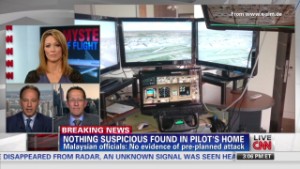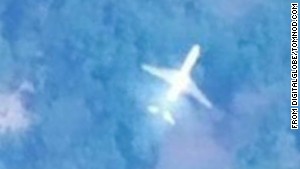Editor's note: Robert Goyer is the editor-in-chief of Flying magazine and a commercial jet-rated pilot.
(CNN) -- There are new reports that an Australian government Orion P-3 surveillance plane has spotted objects afloat in the south Indian Ocean off the coast of Australia. At this early hour, some investigators think this may be from Malaysia Air Flight MH370.
If it really is the wreckage of the Boeing 777-200, its far southern location would provide investigators with precious clues into what terrible events unfolded to result in the disappearance and loss of the airliner carrying 239 people.
The location would suggest a few very important parameters. The spot where searchers have found hoped-for clues is, based on the location information provided by the Australian government, nearly 4,000 miles from where the airliner made its unexpected and as yet unexplained turn to the west.
 Robert Goyer
Robert Goyer Based on ambiguous but solid satellite evidence, investigators now believe the airplane, after its westward deviation, made a turn to the north or the south. They favor a southern path over the Indian Ocean because its remoteness would help explain the lack of radar or satellite sightings of the lost flight.
In addition to the 4,000-mile distance presumably flown, if it flew in a straight line -- a fair guess at this point -- the location is also due south from where the plane went missing, which might be another important clue.
If the suspicious objects spotted in the water turn out to be the wreckage of MH370, we will know a few things. Some of them may sound obvious, but remember -- investigators early on seemed to have missed some clues that should have been obvious, like the computer-inputted course the airplane likely took after it first diverged from its original flight plan.
 Pros/Cons: Is debris part of Flight 370?
Pros/Cons: Is debris part of Flight 370?  'No motive' in disappearance of airplane
'No motive' in disappearance of airplane  Is THAT really the plane?
Is THAT really the plane? The first obvious clue is that the airplane flew for many hours. At a cruising speed of 600 mph, which is simply a ballpark guess at this point, it would have taken the 777 around six hours to reach the site in the Indian Ocean where the airplane would have crashed into the water. That is almost exactly the potential range of the flight that investigators have previously quoted.
The other clue the location provides is its due south direction from Malaysia, suggesting that the airplane flew without human direction to guide it to a safe landing site. At some point long before the presumed crash (again, still speculating here), it would have become impossible for the plane to reach land on the fuel that would have remained in its tanks.
While there are a small number of possible scenarios at play here, the most likely, it seems to me, is that the airplane was flying on autopilot without anyone at the controls and did so until it ran out of fuel and crashed into the ocean. The autopilot almost certainly would have remained working even after the plane ran out of fuel, though the dynamics of such a crash scenario are complex.
For example, would one engine have lost power before the other? And how the airplane crashed -- if that is what happened -- might make a big difference in its eventual recovery. The more controlled its impact with the water was, the more likely it would be that we could ultimately recover large sections of it from the deep ocean floor where, some investigators believe, it might lie.
Follow us on Twitter @CNNOpinion.
Join us on Facebook/CNNOpinion.
{ 0 comments... read them below or add one }
Post a Comment